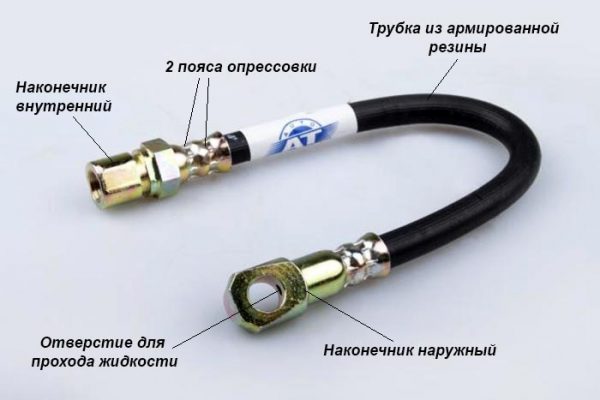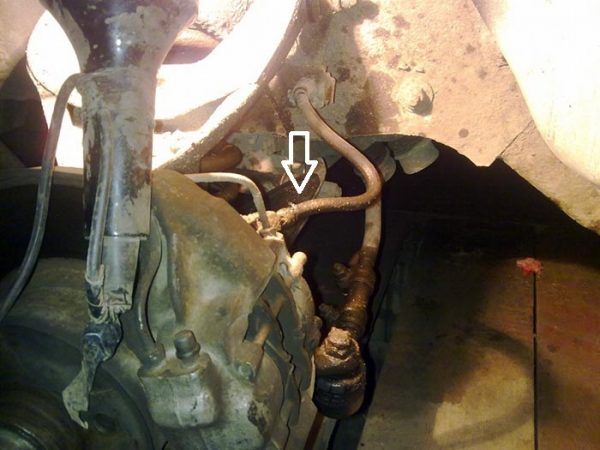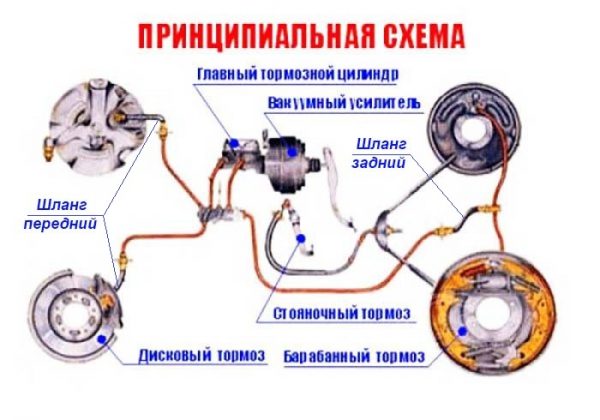
Guide for self-replacement of brake hoses of a VAZ 2107 car
Content
The weak link in the VAZ 2107 brake system is rubber hoses connecting metal liquid tubes to the working cylinders of the front and rear wheels. The pipes are repeatedly bent during the operation of the car, which is why the rubber begins to crack and let fluid through. The problem cannot be ignored - over time, the level in the expansion tank will drop to a critical level and the brakes will simply fail. Replacing defective hoses on the "seven" is not difficult and is often performed by motorists in garage conditions.
Purpose of flexible pipes
The contours of the liquid brakes of the VAZ 2107 are made of metal tubes leading from the main cylinder (abbreviated GTZ) to all wheels. It is impossible to connect these lines directly to the working cylinders, since the wheel brakes are constantly moving relative to the body - the chassis works out bumps, and the front wheels also turn left and right.

To connect the rigid tubes to the calipers, flexible connections are used - brake hoses made of moisture-resistant reinforced rubber. The "seven" has 3 pipes - two on the front wheels, the third supplies fluid to the rear axle brake pressure regulator. Short thin hoses between the expansion tank and the GTZ do not count - they do not have high pressure, spare parts become unusable very rarely.
Flexible eyeliner consists of 3 elements:
- Textile-reinforced flexible hose.
- A steel fitting with an internal thread is pressed onto one end of the branch pipe, into which a mating sleeve of a metal tube is screwed. A groove is made outside the tip for fixing the element to the car body with a special washer.
- The shape of the second fitting depends on the purpose of the hose. For docking with the front mechanisms, an eye with a bolt hole (the so-called banjo fitting) is used, on the rear contour there is a conical threaded tip.
 The branch pipe of the front brake circuit is equipped with a banjo fitting for an M10 bolt
The branch pipe of the front brake circuit is equipped with a banjo fitting for an M10 bolt
The first end of the hose that connects to the circuit tube is always attached with a retaining clip to a special bracket on the body. On the rear axle, the second tip remains free, on the front wheels it is additionally fixed to the calipers with overhead brackets. To prevent liquid from leaking through the threaded connection, 2 copper sealing washers are put on the bolt.

Please note: the hose lug for the front wheels is made at an angle relative to the longitudinal axis of the pipe, as shown in the drawing.

When to change hoses
The service life of the brake rubber pipes is about 3 years if the car is used regularly. A low-quality hose can leak after six months or 2-3 thousand kilometers, or even earlier.
In order not to lose the brakes while driving and not become the culprit of an accident, the owner of the "seven" needs to constantly monitor the technical condition of the flexible hoses and immediately change them if such signs are found:
- when many small cracks appear, indicating critical wear of the rubber shell;
- in case of detection of wet spots of liquid, which most often appear near the very tips;
 Most often, the pipe breaks near the tip, the liquid literally floods the steering rod
Most often, the pipe breaks near the tip, the liquid literally floods the steering rod - in case of mechanical damage and rupture of the pipe;
 All liquid can flow out through a through hole in the pipe, which is noticeable by a decrease in the level in the expansion tank
All liquid can flow out through a through hole in the pipe, which is noticeable by a decrease in the level in the expansion tank - a decrease in the level in the expansion tank is another reason to check the integrity of all connections;
- it is also recommended to replace the hoses after purchasing a used car.

If you ignore the above signs and drive on, the flexible eyeliner will break completely. Consequences: the fluid will quickly flow out of the circuit, the pressure in the system will drop sharply, the brake pedal will fall to the floor when pressed. To minimize the risk of a collision in the event of a brake failure, take the following steps promptly:
- The main thing - do not get lost and do not panic. Remember what you were taught in driving school.
- Pull the handbrake lever to the maximum - the cable mechanism operates independently of the main fluid system.
- Stop the engine without depressing the clutch pedal or disengaging the current gear.
- At the same time, keep an eye on the traffic situation and operate the steering wheel, trying to avoid collision with other road users or pedestrians.
Advice regarding turning off the engine is only suitable for Zhiguli cars of the VAZ 2101-07 series that are not equipped with hydraulic or electric power steering. In modern cars, turning off the engine is not worth it - the "steering wheel" will instantly become heavy.
Video: diagnostics of flexible brake pipes
Which parts are best
The main problem when choosing brake hoses is the saturation of the market with fake low-quality spare parts. Such eyeliners do not last long, quickly become covered with cracks or begin to leak near the pressed tips literally a week after installation. How to choose the right rubber pipes:
- Do not purchase cheap bulk hoses sold by the piece. Usually the front tubes come in pairs.
- Carefully examine the metal surfaces of the mounting fittings - they should not leave traces of rough machining - notches, grooves from the cutter and similar defects.
- Examine the markings on the rubber tube. As a rule, the manufacturer puts his logo and indicates the catalog number of the product, which matches the inscription on the package. Some hieroglyphs clearly indicate the origin of the spare part - China.
- Try stretching the tube. If the rubber stretches like a hand expander, refrain from buying. Factory hoses are quite stiff and difficult to stretch.


An additional sign of a quality product is 2 pressing circuits instead of one. Counterfeit pipes are not made so carefully.
Proven brands that produce brake pipes of decent quality:
- BRT - Balakovo plant of rubber products;
- DAAZ - Dimitrovgrad Aggregate Plant;
- "Belmag";
- POWER TECH;
- Fenox.


The hoses of the Balakovo plant are considered original. The parts are sold in a transparent package with a hologram, the marking is embossed (molded together with a rubber product), and not a colored inscription with paint.
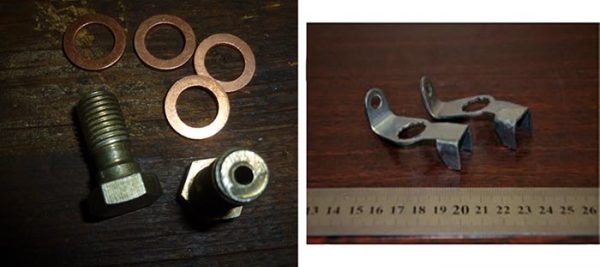

Together with a set of front pipes, it is worth buying 4 new o-rings made of copper 1,5 mm thick, since the old ones are probably flattened from strong tightening. It also doesn’t hurt to make sure that there are fixing brackets that are screwed to the calipers - many drivers do not bother to install them.
Video: how to distinguish counterfeit parts


Watch this video on YouTube
Instructions for replacing eyeliners
Worn or damaged brake hoses cannot be repaired. If any defect is found, it will definitely be replaced. Causes:
- a small crack and fluid leakage from the nozzle can lead to brake failure and a major accident;
- the non-separable design of the hose does not imply the restoration or replacement of the damaged part;
- sealing a through crack with improvised means will not work - due to the high pressure in the line, the liquid will still leak out when the brake pedal is pressed.
To disassemble and install new flexible hoses, it is advisable to drive the car into a viewing hole or overpass. If the front pipes can still be changed without a ditch, then getting to the rear is much more difficult - you have to lie under the car, lifting the left side with a jack.
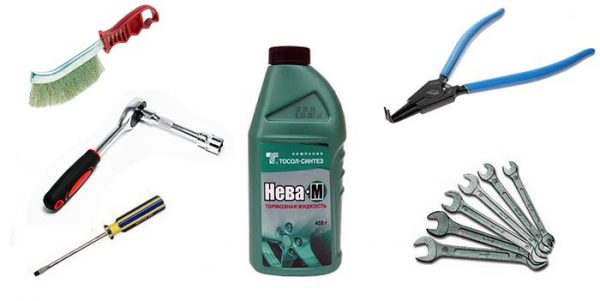

To change worn pipes, you must have the following tool:
- wheel removal kit - wheel wrench, jack, wheel chocks;
- open-end wrenches 8-17 mm in size;
- brush with metal bristles;
- flat screwdriver;
- head 14 with a crank;
- passages;
- aerosol composition WD-40;
- rags.
To loosen metal brake pipes, it is recommended to use a special wrench with a slot for a 10 mm nut. If you work with an ordinary open-end wrench, you can easily lick the edges on the coupling. The nut will have to be loosened by a barbaric method - with a hand vise or a pipe wrench, and then change the tube.
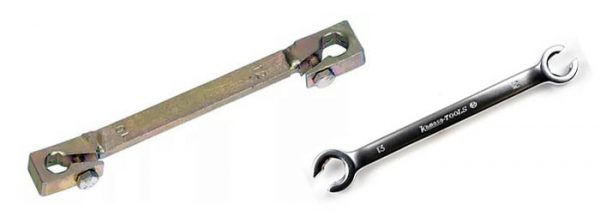

During the replacement process, loss of brake fluid is inevitable. Prepare a supply of this material for topping up and buy a rubber boot (these are placed on the fittings of brake calipers) to block the flow of fluid from an unscrewed iron tube.
Installing the front hoses
Before starting repair work, prepare the VAZ 2107 fluid brake system for disassembly:
- Set the car on a viewing hole, turn on the handbrake, open the hood.
- Unscrew the cap of the brake expansion tank and move it aside, placing a rag on it. Fill the container with fresh fluid to the maximum.
- Unscrew the cap from the clutch reservoir located nearby.
- Take a piece of plastic film, fold it 2-4 times and cover the brake reservoir neck. Screw the plug from the clutch reservoir on top and tighten by hand.

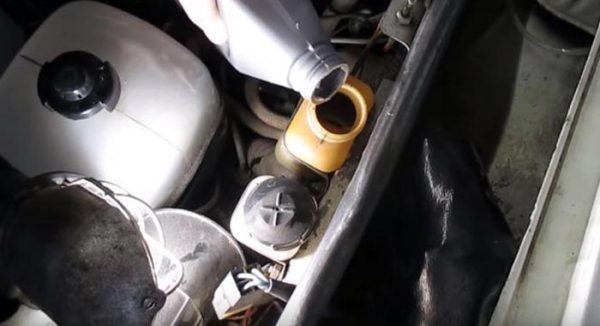 To prevent air from entering the system, you must first add fluid to the tank and tightly close the top with a lid
To prevent air from entering the system, you must first add fluid to the tank and tightly close the top with a lid
Now, when the system is depressurized (due to disassembly), a vacuum is formed in the tank, which does not allow the liquid to escape through the removed tube. If you work carefully and follow further recommendations, air will not enter the disassembled circuit, and very little fluid will flow out.
Having prepared the system for depressurization, install wheel chocks and remove the front wheel from the desired side. Further work order:
- Clean with a brush the junctions of the brake hose with the main line and caliper. Treat the joints with WD-40 grease, wait 5-10 minutes.
- Put a special key on the metal tube coupling and tighten it with a bolt. While holding the nozzle tip with a 17 mm open-end wrench, loosen the nut.

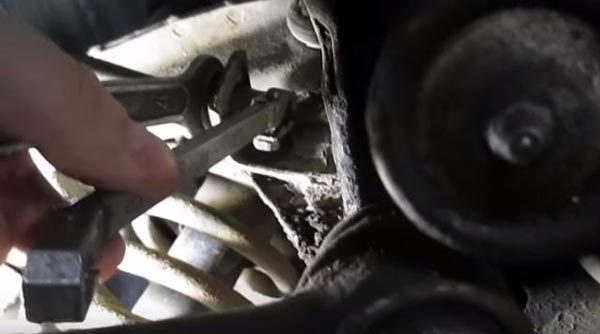 When unscrewing the coupling, the hose end must be held with a 17 mm wrench
When unscrewing the coupling, the hose end must be held with a 17 mm wrench - Remove the special wrench and finally unscrew the coupling using a standard tool. Move the end of the tube and put on it a rubber boot purchased in advance.

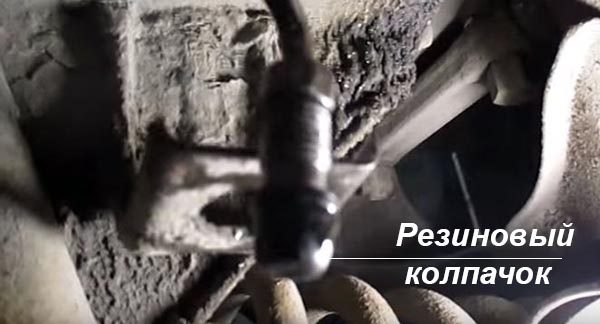 The hole of the removed pipe is easiest to close with a rubber cap from the caliper fitting
The hole of the removed pipe is easiest to close with a rubber cap from the caliper fitting - Use pliers to remove the retaining clip to release the fitting from the bracket.
- Use a flat screwdriver to unscrew the screw holding the overlay bracket to the caliper, remove the part.
- With a 14 mm head, unscrew the bolt holding the second end of the pipe. Wipe the seat dry with a rag.

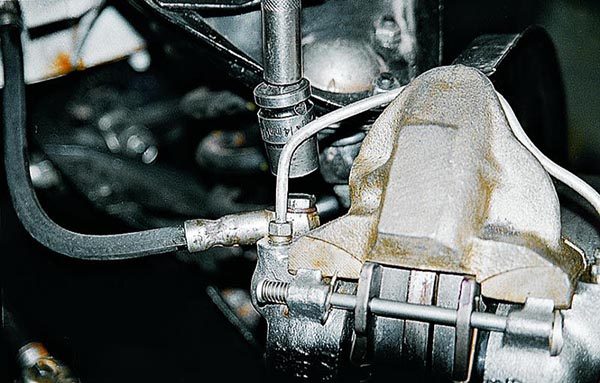 Usually the clamping bolt is tightened with great effort, it is better to unscrew it with a head with a knob
Usually the clamping bolt is tightened with great effort, it is better to unscrew it with a head with a knob - After replacing the copper washers, screw the bolt with the new hose onto the caliper. Pay attention to the correct installation - the plane of the tip should tilt down, not up.

 If you look at a correctly installed fitting from the side, the hose will point down
If you look at a correctly installed fitting from the side, the hose will point down - Pass the second fitting through the eye of the bracket, remove the rubber boot from the tube and screw the ferrule into the ferrule, tightening with a 10 mm open-end wrench.
- Unscrew the baited bolt with your hand, slightly open the cap of the expansion tank and wait until liquid comes out of the tip. Install the fitting in place and tighten the bolt by tightening the head.
- Insert the fixing washer into the bracket and carefully wipe the areas where the brake fluid has entered. Attach the clamp with the screw, adjusting the position of the bolt head.

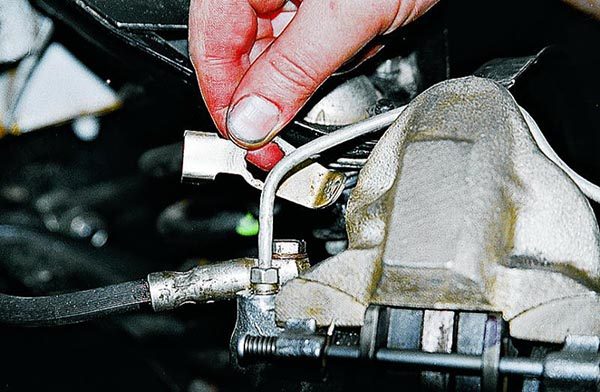 The overhead retainer is put on the head of the tightened bolt and screwed to the caliper with a screw
The overhead retainer is put on the head of the tightened bolt and screwed to the caliper with a screw
When connecting a new pipe to the main pipe, do not fuss and do not rush, otherwise you risk distorting the coupling and stripping the thread. It is better to add a portion of liquid than to buy and change damaged tubes.
After installing the branch pipe, replace the cover of the expansion tank and try to apply the brake several times. If the pedal does not fail, then the operation was successful - no air entered the system. Otherwise, proceed to pumping or replacing the remaining hoses.
Video: tips for replacing front hoses


Watch this video on YouTube
How to change the rear pipe
The algorithm for replacing this hose differs little from the installation of front rubber products. There is a slight difference in the method of attachment - the rear end of the pipe is made in the form of a cone, which is screwed into the tee. The latter is installed on the rear axle housing. The order of work looks like this:
- Preparation for disassembly - installation of a sealed gasket under the cap of the expansion tank.
- Cleaning the dirt with a brush, treating the joints with an aerosol lubricant and unscrewing the iron tube coupling from the hose.

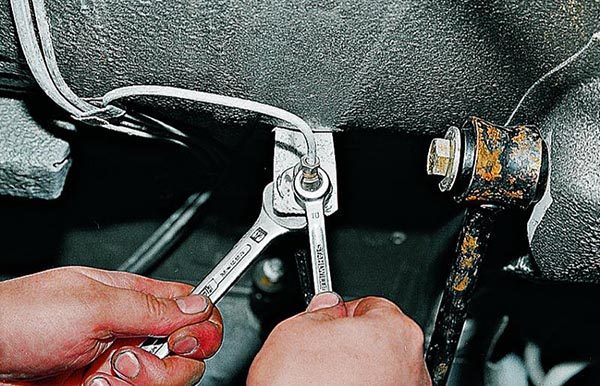 The mounting of the rear pipe is identical to the front one - the line coupling is screwed into the hose end
The mounting of the rear pipe is identical to the front one - the line coupling is screwed into the hose end - Removing the fixing bracket, unscrewing the second fitting from the tee with an open-end wrench.

 Plate - the latch is easily removed with pliers for the bent end
Plate - the latch is easily removed with pliers for the bent end - Install the new rear hose in reverse order.

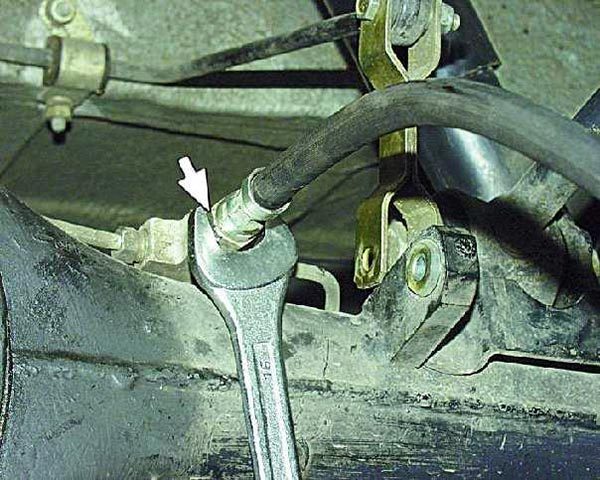 The second end of the pipe is unscrewed from the tee with an ordinary open-end wrench
The second end of the pipe is unscrewed from the tee with an ordinary open-end wrench
Since the cone fitting rotates with the hose, it will not be possible to force air out with fluid. The tip is twisted with a tee in the first place, then the main tube is connected. The rear circuit will have to be pumped.
Video: rear axle brake hose replacement


Watch this video on YouTube
About bleeding the brakes
To carry out the operation in the traditional way, you will need the services of an assistant. Its job is to repeatedly depress and hold the brake pedal while you bleed air through the fittings on each wheel. The procedure is repeated until there are no air bubbles left in the transparent tube connected to the fitting.
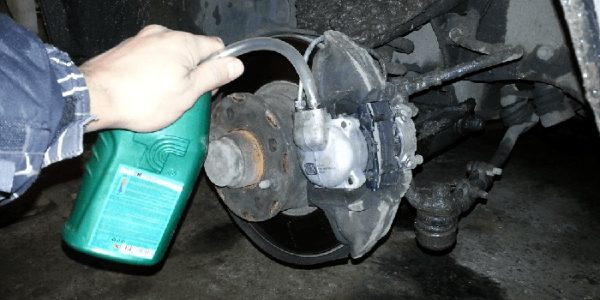

Before pumping, do not forget to add fluid to the tank. Waste material with air bubbles that you have drained from the brakes must not be reused.
To pump the brakes without an assistant, you need to have a mini-compressor for tire inflation and make a fitting - an adapter in the form of an expansion tank plug. The supercharger is connected to the spool and pumps up a pressure of 1 bar, simulating the pressing of the brake pedal. Your task is to loosen the fittings, let out air and add new fluid.
The integrity of the brake hoses must be constantly monitored, especially when the elements are decently worn out. We noticed a grid of small cracks or a rush with protruding textiles - purchase and install a new pipe. Spare parts do not have to be changed in pairs, it is allowed to install hoses one by one.


